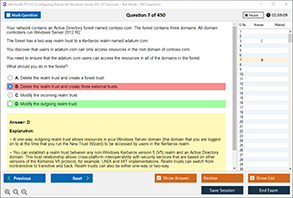
The Complete Financial Modeling and Valuation Course
Best Seller
133 Lectures
6h 33m 18s
Prepare for your Microsoft examination with our training course. The No_code course contains a complete batch of videos that will provide you with profound and thorough knowledge related to Microsoft certification exam. Pass the Microsoft No_code test with flying colors.
$13.99$24.99
Curriculum For This Course
- 1. What does the course cover? 2m 26s
- 1. Introduction to Excel - Welcome Lecture 37s
- 2. Overview of Excel 3m 39s
- 3. Basic Manipulations with Rows & Columns 1m 48s
- 4. The Excel Ribbon 2m 42s
- 5. Data Entry in Excel 3m 3s
- 6. Introduction to Formatting 5m 38s
- 7. Introduction to Excel Formulas 2m 58s
- 8. Introduction to Excel Functions 3m 47s
- 9. Cut, Copy & Paste 2m 8s
- 10. Paste Special 1m 28s
- 1. Excel Best Practices - Welcome Lecture 41s
- 2. Initial formatting of an Excel sheet in order to render it professional 1m 53s
- 3. Fast scrolling through Excel sheets 1m 29s
- 4. Introduction to fixing of cell references 2m 8s
- 5. Using the Alt plus Enter combination 38s
- 6. Learn how to organize your data with Text to Columns 1m 53s
- 7. Learn how to Use the Wrap Text Button 44s
- 8. Create easily printable documents in Excel by using Set Print Area 1m 11s
- 9. Find and select special types of cells with Select Special (F5) 1m 31s
- 10. Learn how to assign dynamic names within a Financial Model 1m 21s
- 11. Define a named range in Excel 1m 34s
- 12. Assign custom formats to specific cells within a Financial Model (ex 1m 33s
- 13. Macros are a great timesaver! Here's why! 2m 51s
- 14. Create a drop-down list by using Data Validation 1m 44s
- 15. Using Custom-sort in order to sort multiple columns within a table 1m 23s
- 16. Create a great Index page at the beginning of your models - Hyperlinks 1m 12s
- 17. Fix the top row of your table with Freeze Panes 1m 11s
- 18. Filter by color - an excellent tool 1m 44s
- 19. Working with conditional formatting 5m 40s
- 1. Keyboard Shortcuts Save LOTS of time in Excel 4m 32s
- 1. Excel's Key Functions - Welcome Lecture 45s
- 2. Key Excel Functions: Sum, Sumif and Sumifs 4m 20s
- 3. Key Excel Functions: Count, Counta, Countif, Countifs 4m
- 4. Key Excel Functions: Average and Averageif 1m 53s
- 5. Elaborate text efficiently: Left, Right, Mid, Upper, Lower,Proper, Concatenate 4m 24s
- 6. Find the minimum or maximum value in a range of cells in Excel 51s
- 7. Include Round in your Financial Models 1m 1s
- 8. Learn how to transfer data efficiently in Excel: Vlookup and Hlookup 7m 31s
- 9. Index, Match and their combination - the perfect substitute of Vlookup 7m 18s
- 10. A great Excel technique: Index, Match, Match 4m 59s
- 11. Using Excel's Iferror function to trap spreadsheet errors 1m 42s
- 12. Learn how to render your models flexible with Choose 2m 18s
- 13. Use Goal Seek in order to find the result that you are looking for 2m 13s
- 14. Include sensitivity analysis in your models through Data Tables 4m 6s
- 15. Excel's dynamic and interactive tables: Pivot tables 2m 12s
- 1. Exercise - Excel's "Sumifs" function - explained & solved 8m
- 1. Future and present values in Excel 7m 2s
- 2. Calculating the rate of return of an investment with the IRR function 3m 30s
- 3. Calculating a complete loan schedule in Excel 6m 16s
- 4. Date functions in Excel 5m 38s
- 1. Introduction to Pivot Tables & Their Application 1m 30s
- 2. Creating Pivot Tables is easy! 3m 42s
- 3. Give Your Excel Pivot Tables a Makeover 2m 9s
- 4. Modifying and Pivoting Fields In Order to Obtain the Pivot Table that You Need 4m 28s
- 5. Learn More About GetPivotData - A Very Important Excel Function 3m 40s
- 6. An Introduction to Slicers - The Moden Day Pivot Table Filters 4m 20s
- 1. Case Study - Build a P&L From Scratch - Welcome Lecture 1m 2s
- 2. Introduction to the Case Study 37s
- 3. Understand your data source before you start working on It 2m 22s
- 4. Order the source worksheets 1m 57s
- 5. Create a code: the best way to organize your data and work efficiently with It 1m 48s
- 6. Learn how to create a Database 1m 50s
- 7. Use Vlookup in order to fill the Database sheet 5m 17s
- 8. Use Sumif in order to complete the Database sheet 4m 7s
- 9. Use Index & Match as a substitute of Vlookup 3m 59s
- 10. Mapping of the rows in the Database sheet 2m 7s
- 11. Building the structure of the P&L sheet 1m 59s
- 12. Formatting sets You apart from the competition in Excel - A Practical Example 3m 15s
- 13. Populate the P&L sheet with Sumif 2m 39s
- 14. Learn how to find mistakes with Countif 2m 17s
- 15. Calculating year-on-year percentage variations the proper way 2m 59s
- 16. Create professional and good-looking charts - Introduction 20s
- 17. Build a Column Stacked Chart with a secondary line axis in Excel 5m 52s
- 18. Learn how to build effective Doughnut Charts in Excel 4m 6s
- 19. Learn how to build an Area Chart in Excel 4m 1s
- 20. Learn how to create Bridge Charts 10m 41s
- 1. Introduction to the Case Study 1m 55s
- 2. Preliminary mapping of the data extraction 2m 5s
- 3. Working with an SAP data extraction 3m 17s
- 4. Creating an output structure of the FMCG model 2m 24s
- 5. Improving the layout and appearance of the FMCG report 4m 13s
- 6. Inserting formulas and automating calculations 2m 25s
- 7. Creating a Master Pivot Table: The main data source for the FMCG report 1m 50s
- 8. GetPivotData is great! Extracting data from the Master Pivot Table 5m 40s
- 9. Combining Slicers and GetPivotData: The key to our success 3m 14s
- 10. Getting fancy with Excel slicers - Good-looking Excel slicers 3m 7s
- 11. This is how the report can be used in practice by high-level executives 3m 54s
- 1. Financial Modeling Basics - Welcome Lecture 42s
- 2. What is a Financial model? 2m 2s
- 3. Why use Financial models? 2m 35s
- 4. Financial modeling: Worst Practices - Things you should avoid 5m 49s
- 5. Financial modeling: Best practices 4m 58s
- 6. Financial modeling: The types of models that are built in practice 4m 42s
- 7. Financial modeling: The right level of detail in a model 2m 35s
- 8. Financial modeling: Forecasting guidelines 2m 51s
- 9. Building a complete model - Important considerations 2m 15s
- 10. Modeling the Income statement 5m 58s
- 11. Modeling the Balance sheet - Part 1 2m 35s
- 12. Modeling the Balance sheet - Part 2 5m 8s
- 1. Valuation Case Study - Welcome Lecture 33s
- 2. Introduction to the DCF exercise 1m 7s
- 3. The various stages of a complete DCF Valuation 6m 30s
- 4. Description of the structure of the DCF model 2m 53s
- 5. A glimpse at the company we are valuing - Cheeseco 1m 9s
- 6. Modeling the top line 3m 39s
- 7. Introducing scenarios to the model with Choose 2m 12s
- 8. Modeling other items: Other revenues and Cogs 3m 46s
- 9. Modeling other items: Operating expenses and D&A 2m 33s
- 10. Modeling other items: Interest expenses, Extraordinary items and Taxes 2m 28s
- 11. Forecasting Balance Sheet items 43s
- 12. An introduction to the "Days" methodology 1m 35s
- 13. Calculation of DSO, DPO and DOI for the historical period 1m 30s
- 14. Forecasting DSO, DPO and DOI 2m 23s
- 15. Forecasting Property, Plant & Equipment, Other assets and Other liabilities 2m 27s
- 16. Creating an output P&L sheet 2m 36s
- 17. Populating the output P&L sheet 2m 14s
- 18. Populating the output BS sheet 1m 49s
- 19. Completing the output BS sheet for the historical period 3m 41s
- 20. Creating a structure for the calculation of Unlevered Free Cash Flows 3m 5s
- 21. Bridging Unlevered Free Cash Flow to Net Cash Flow 1m 55s
- 22. Calculating Unlevered Free Cash Flow 6m 1s
- 23. Calculating Net Cash Flow 3m 56s
- 24. Obtaining the rest of the Cash Flows through Find and Replace 3m 52s
- 25. Introducing Weighted Average Cost of Capital and Perpetuity Growth 1m 56s
- 26. Discounting Unlevered Free Cash Flows in order to obtain their Present Value 2m 50s
- 27. Calculating Continuing Value and Enterprise Value of the business 2m 17s
- 28. Calculating Equity Value 1m 21s
- 29. Sensitivity analysis for WACC and perpetuity growth 4m 17s
- 30. A possible application of Goal Seek 1m 40s
- 31. Using charts in order to summarize the results of the DCF Model 4m 38s
- 32. You Made It! 2m 16s
- 33. Congratulations!! 1m 2s
Hot Exams
How to Open Test Engine .dumpsqueen Files
Use FREE DumpsQueen Test Engine player to open .dumpsqueen files


Your purchase with DumpsQueen.com is safe and fast.
The DumpsQueen.com website is protected by 256-bit SSL from Cloudflare, the leader in online security.
